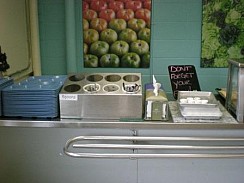June 23, 2015
I recently finished a project working to help expand recycling and implement composting in four schools in Southwest Vermont. The schools in the project—Arlington High School/Middle School, Fisher Elementary, Monument Elementary, and Flood Brook (K-8) successfully expanded their recycling where necessary and implemented food scrap collection for composting five days per week.
 All of the schools use washable trays for lunch service. The elementary schools all use washable silverware as well. Both Monument and Flood Brook cafeteria staff also do a great job of using bulk condiment dispensers. Flood Brook in particular, under the direction of Food Service Director Kelly Foster, is to be commended for their commitment to both reducing waste and controlling costs through bulk food purchasing.
All of the schools use washable trays for lunch service. The elementary schools all use washable silverware as well. Both Monument and Flood Brook cafeteria staff also do a great job of using bulk condiment dispensers. Flood Brook in particular, under the direction of Food Service Director Kelly Foster, is to be commended for their commitment to both reducing waste and controlling costs through bulk food purchasing.
Flood Brook uses bulk dispensers for all condiments and salad dressings. Cafeteria staff also purchase items such as dried beans, applesauce, and other foods in bulk. Students use a large spoon to dish up the applesauce and similar items directly onto their trays, thus eliminating the use of disposable containers or single-serve packaging typically found at other schools.
The Flood Brook cafeteria staff is also completely on-board with the school’s composting effort. Staff help to monitor the cafeteria collection bins to ensure that no contaminants are found. At the end of the lunch periods, cafeteria staff transport the collected food scraps to outside carts for storage. The cafeteria staff also wash the collection buckets. Flood Brook presents a model for cafeteria waste reduction for other schools.
The Urban School Food Alliance, recently announced it had worked with school districts in six major cities—New York, Los Angeles, Chicago, Dallas, Miami, and Orlando—to switch from polystyrene disposable plates to compostable ones. According to the Alliance, it has developed an affordable compostable plate made from recycled newspaper that costs about a penny per plate more than polystyrene ones. Provided the participating schools compost, this will certainly keep a lot of plates out of the landfill.
Perhaps these schools are waste reduction and composting trendsetters. I know from working with schools that cafeteria staff are under a lot of pressure to serve nutritious meals (while trying to make food kids will eat) and to control costs. Adding waste reduction and composting into the mix isn’t always easy. However, my experience is that once farsighted cafeteria staff such as the ones at Flood Brook figure out a system that works, nutritious and tasty meals can be produced for students while also saving schools money and reducing waste.
Tips for Cafeteria Waste Reduction
Through implementation of waste minimization practices, school district food service managers can lower overhead expenses and reduce disposal costs while still providing for the nutritional needs of students. School districts can reduce waste 40 – 60% by implementing policies that reduce the amount of uneaten food, reduce or eliminate disposables, address food prep waste and packaging, and implement recycling and composting.
Cafeteria Waste Audit
The first step in reducing the amount of waste a school cafeteria produces is to conduct a waste audit of both the kitchen prep area (“pre-consumer”) and the student dining hall (“post-consumer”). See NERC’s Waste Audit and Waste Assessment and Waste Assessment and Waste Audit forms for specific information.
Once completed, the results of the waste audit will provide an overview of existing food service practices and how they generate inefficiency and waste. Questions to be addressed in the waste audit include:
- What is being thrown out and why?
- Is there a waste reduction or reuse option for dealing with it?
- Could it be recycled or composted?
- If it is food that went bad, was it incorrectly dated or not rotated?
- Were cooked items burnt?
- Are certain items given in too large a portion?
- What waste reduction and waste diversion practices are already in place?
- Are all personnel participating in these efforts?
The answers to these questions will guide the development of a plan for waste reduction and cost savings.
More cafeteria waste reduction tips will be included in future articles.
By Athena Lee Bradley



Comments (0)
Add a Comment